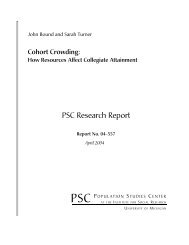Population Ageing and the Well-Being of Older Persons in Thailand ...
Population Ageing and the Well-Being of Older Persons in Thailand ...
Population Ageing and the Well-Being of Older Persons in Thailand ...
You also want an ePaper? Increase the reach of your titles
YUMPU automatically turns print PDFs into web optimized ePapers that Google loves.
Section 5: Family support <strong>and</strong><br />
<strong>in</strong>tergenerational exchanges<br />
In Thail<strong>and</strong>, as <strong>in</strong> South-East Asia generally <strong>and</strong> much<br />
<strong>of</strong> <strong>the</strong> develop<strong>in</strong>g world beyond, <strong>in</strong>formal systems <strong>of</strong><br />
social <strong>and</strong> economic exchange with<strong>in</strong> <strong>the</strong> family play<br />
a crucial role <strong>in</strong> determ<strong>in</strong><strong>in</strong>g <strong>the</strong> well be<strong>in</strong>g <strong>of</strong> <strong>the</strong> older<br />
age population (World Bank 1994). Of particular<br />
importance are <strong>in</strong>tergenerational exchanges <strong>of</strong> services<br />
<strong>and</strong> material <strong>and</strong> social support between elderly<br />
parents <strong>and</strong> <strong>the</strong>ir adult children as well as <strong>the</strong> liv<strong>in</strong>g<br />
arrangements with which <strong>the</strong>y are <strong>in</strong>extricably<br />
entw<strong>in</strong>ed. In this section, we exam<strong>in</strong>e <strong>the</strong> nature <strong>and</strong><br />
extent <strong>of</strong> family support <strong>and</strong> <strong>in</strong>tergenerational<br />
exchanges, <strong>in</strong>clud<strong>in</strong>g liv<strong>in</strong>g arrangements, material<br />
support <strong>and</strong> social contact.<br />
5.1 Liv<strong>in</strong>g Arrangements<br />
General considerations. Many aspects <strong>of</strong> well-be<strong>in</strong>g<br />
<strong>of</strong> older persons are <strong>in</strong>fluenced by <strong>the</strong>ir liv<strong>in</strong>g<br />
arrangements. In Thail<strong>and</strong>, as <strong>in</strong> most <strong>of</strong> East <strong>and</strong><br />
South-East Asia, liv<strong>in</strong>g with or nearby adult children<br />
has been a predom<strong>in</strong>ant pattern. While household<br />
composition is <strong>the</strong> most common <strong>and</strong> readily<br />
available <strong>in</strong>dicator <strong>of</strong> liv<strong>in</strong>g arrangements, <strong>the</strong><br />
implications <strong>of</strong> particular configurations def<strong>in</strong>ed by<br />
such <strong>in</strong>formation can be ambiguous. One serious<br />
limitation is that such measures do not encompass<br />
<strong>in</strong>formation about o<strong>the</strong>rs who live next door or very<br />
nearby <strong>and</strong> may still play an important role <strong>in</strong> <strong>the</strong><br />
lives <strong>of</strong> elderly (Knodel & Saengtienchai 1999).<br />
Ano<strong>the</strong>r difficulty arises because <strong>the</strong> mean<strong>in</strong>g <strong>of</strong><br />
liv<strong>in</strong>g arrangements can not be <strong>in</strong>ferred with any<br />
certa<strong>in</strong>ty simply from <strong>the</strong>ir form (Hermal<strong>in</strong> 1997).<br />
Thus measures <strong>of</strong> composition <strong>of</strong> households <strong>in</strong> which<br />
elderly reside can be suggestive but <strong>the</strong>y need to be<br />
<strong>in</strong>terpreted cautiously.<br />
With that said, it is still true that co-residence with<br />
one or more adult children, typically <strong>in</strong> a stem family<br />
configuration, is a long st<strong>and</strong><strong>in</strong>g tradition <strong>in</strong><br />
Thail<strong>and</strong> <strong>and</strong> viewed as an essential way for families<br />
to meet <strong>the</strong> needs <strong>of</strong> older dependent members.<br />
Extensive qualitative research has documented that<br />
older Thais <strong>the</strong>mselves <strong>of</strong>ten view liv<strong>in</strong>g arrangements<br />
that permit frequent access between <strong>the</strong> two<br />
generations as crucial to <strong>the</strong>ir own well-be<strong>in</strong>g (Knodel,<br />
Saengtienchai & Sittitrai 1995). In contrast, liv<strong>in</strong>g<br />
alone is usually viewed as a disadvantage for several<br />
reasons. Not only is it likely to be associated with less<br />
frequent <strong>in</strong>terpersonal <strong>in</strong>teractions, <strong>and</strong> hence<br />
feel<strong>in</strong>gs <strong>of</strong> lonel<strong>in</strong>ess, but <strong>the</strong>re is also a greater chance<br />
that urgent needs for assistance, created for example<br />
by an acute health crisis or accident, will go<br />
unnoticed longer than if o<strong>the</strong>rs are present <strong>in</strong> <strong>the</strong><br />
household. In some cases, liv<strong>in</strong>g alone may even<br />
signify desertion by o<strong>the</strong>rs. Although liv<strong>in</strong>g only with<br />
a spouse also <strong>in</strong>dicates that adult children or o<strong>the</strong>r<br />
younger generation k<strong>in</strong> are not present <strong>in</strong> <strong>the</strong><br />
household, it is generally viewed as less problematic<br />
than liv<strong>in</strong>g alone s<strong>in</strong>ce a spouse can be a pr<strong>in</strong>cipal<br />
source <strong>of</strong> emotional <strong>and</strong> material support <strong>and</strong><br />
personal care dur<strong>in</strong>g illness or frailty. Co-residence can<br />
benefit both generations but <strong>the</strong> balance typically shifts<br />
over <strong>the</strong> life course until eventually parents reach ages<br />
<strong>in</strong> which <strong>the</strong>ir contributions are dim<strong>in</strong>ished <strong>and</strong> <strong>the</strong>y<br />
become largely dependent on o<strong>the</strong>rs for care <strong>and</strong><br />
support.<br />
Trends. Given <strong>the</strong> central role that liv<strong>in</strong>g with<br />
children has traditionally played <strong>in</strong> <strong>the</strong> context <strong>of</strong><br />
family support <strong>in</strong> Thail<strong>and</strong>, we start our exploration<br />
39















